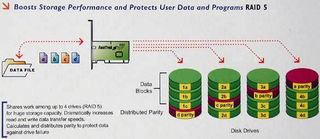RAID 5 Scaling Tests With Up To Eight Drives
All-around Solution: RAID 5

This configuration is taken from the packaging of a Promise controller. The data storage illustration is easy to follow, which in this example is on a total of four hard drives.
A RAID 5 requires at least three hard drives and operates all drives almost simultaneously. In order to ensure data security, a parity bit is calculated for each information unit and saved on one of the available drives on a rotating basis.
Now the question arises: what is the ideal number of drives? More drives fundamentally mean a greater risk of failures as well as higher energy requirements, while performance may suffer to an unacceptable degree with only a few drives. We tested all configurations, using up to eight drives.
| System Components | |
|---|---|
| Processor(s) | Dual Intel Pentium 4 Xeon, 2.8 GHz, 512 kB Cache, FSB 533 |
| Memory | 2x 512 MB PC2100 Registered ECC, Samsung |
| Motherboard | Asus PP-DLW, Rev. 1.03 Intel E7505 Chipset |
| Graphics Card | Matrox Millennium G450, AGP, 32 MB |
| Storage Subsystem | |
| System Hard Drive | Western Digital WD1200JB, 120 GB 7,200 rpm, 8 MB Cache |
| RAID Controller | Raidcore RC4000 PCI-X |
| Hard Drives | 8x Western Digital WD360 Raptor, 10,000 rpm, 8 MB Cache |
| Software | |
| Intel Chipset | Intel Chipset Installation Utility 5.1.1.1002 |
| RAID Controller Driver | Raidcore Driver 1.0.RC-100-200461.2 |
| DirectX | 9.0b |
| OS | Windows XP Professional Build 2600 Service Pack 1 |
Stay on the Cutting Edge
Join the experts who read Tom's Hardware for the inside track on enthusiast PC tech news — and have for over 25 years. We'll send breaking news and in-depth reviews of CPUs, GPUs, AI, maker hardware and more straight to your inbox.
Current page: All-around Solution: RAID 5
Prev Page RAID 5 Scaling Tests Using Three To Eight Drives Next Page Test Drives: Western Digital WD360 RaptorMost Popular

